Bio-Guided Isolation of Acetogenins from Annona cherimola Deciduous Leaves: Production of Nanocarriers to Boost the Bioavailability Properties
Abstract
1. Introduction
2. Results and Discussion
2.1. Bio-Guided Isolation
2.2. Cytotoxic Activities of Isolated ACGs
2.3. Synthesis of SMPMs of Annonacin
2.4. Characterization of SMPMs by NMR Spectroscopy and Electron Microscopy
2.5. Controlled Release Study
2.6. Cytotoxicity Bioassay on SMPMs of Annonacin
3. Materials and Methods
3.1. General Experimental Procedures
3.2. Chemicals
3.3. Plant Material
3.4. Extraction and Isolation
3.5. Synthesis of SMPMs-ACGs
3.6. Electron Microscopy
3.7. Encapsulation Efficiency
3.8. Compound Release
3.9. Bioavailability Studies
3.10. Cell Lines and Cell Cultures
3.11. Cell Viability Assay
3.12. Fluorescence Microscopy
4. Conclusions
5. Patents
Supplementary Materials
Author Contributions
Funding
Acknowledgments
Conflicts of Interest
References
- Liaw, C.C.; Wu, T.Y.; Chang, F.-R.; Wu, Y.C. Historic perspectives on annonaceous acetogenins from the chemical bench to preclinical trials. Planta Med. 2010, 76, 1390–1404. [Google Scholar] [CrossRef] [PubMed]
- Bermejo, A.; Figadère, B.; Zafra-Polo, M.C.; Barrachina, I.; Estornell, E.; Cortes, D. Acetogenins from Annonaceae: Recent progress in isolation, synthesis and mechanisms of action. Nat. Prod. Reports 2005, 22, 269–303. [Google Scholar] [CrossRef] [PubMed]
- Zafra-Polo, M.; González, M.; Estornell, E.; Sahpaz, S.; Cortes, D.; Martínez, D.C. Acetogenins from annonaceae, inhibitors of mitochondrial complex I. Phytochemistry 1996, 42, 253–271. [Google Scholar] [CrossRef]
- Smith, R.E.; Tran, K.; Richards, K.M. Bioactive annonaceous acetogenins. In Studies in Natural Products Chemistry; Atta-ur-Rahman, Ed.; Elsevier BV: Amsterdam, The Netherlands, 2014; Volume 41, pp. 95–117. ISBN 9780444632944. [Google Scholar]
- Oberlies, N.H.; Chang, A.C.J.; McLaughlin, J.L. Structure−activity relationships of diverse annonaceous acetogenins against multidrug resistant human mammary adenocarcinoma (MCF-7/Adr) Cells. J. Med. Chem. 1997, 40, 2102–2106. [Google Scholar] [CrossRef] [PubMed]
- Miyoshi, H.; Ohshima, M.; Shimada, H.; Akagi, T.; Iwamura, H.; McLaughlin, J.L. Essential structural factors of annonaceous acetogenins as potent inhibitors of mitochondrial complex I. Biochim. Biophys. Acta 1998, 1365, 443–452. [Google Scholar] [CrossRef]
- Díaz-De-Cerio, E.; Saez, L.M.A.; Gómez-Caravaca, A.M.; Verardo, V.; Fernández-Gutiérrez, A.; Fernández, I.; Arráez-Román, D. Characterization of bioactive compounds of Annona cherimola L. leaves using a combined approach based on HPLC-ESI-TOF-MS and NMR. Anal. Bioanal. Chem. 2018, 410, 3607–3619. [Google Scholar] [CrossRef]
- Wele, A.; Landon, C.; Labbe, H.; Vovelle, F.; Zhang, Y.; Bodo, B. Sequence and solution structure of cherimolacyclopeptides A and B, novel cyclooctapeptides from the seeds of Annona cherimola. Tetrahedron 2004, 60, 405–414. [Google Scholar] [CrossRef]
- Jamkhande, P.G.; Ajgunde, B.R.; Jadge, D.R. Annona cherimola Mill. (Custard apple): A review on its plant profile, nutritional values, traditional claims and ethnomedicinal properties. Orient. Pharm. Exp. Med. 2017, 17, 189–201. [Google Scholar] [CrossRef]
- Rodríguez-Sánchez, D.G.; Pacheco, A.; Villarreal-Lara, R.; Ramos-González, M.R.; Ramos-Parra, P.A.; Granados-Principal, S.; De La Garza, R.I.D.; Garcia-Rivas, G.; Brenes, C.H.; De La Garza, R.I.D. Chemical profile and safety assessment of a food-grade acetogenin-enriched antimicrobial extract from avocado seed. Molecules 2019, 24, 2354. [Google Scholar] [CrossRef]
- González, E.M.; Fernández, A.E.L.; Sáyago-Ayerdi, S.G.; Estrada, R.M.V.; Vallejo, L.G.Z. In vitro antioxidant capacity of crude extracts and acetogenin fraction of soursop fruit pulp. Pharm. Anal. Acta 2017, 8, 1–7. [Google Scholar] [CrossRef]
- Guillopé, R.; Escobar-Khondiker, M.; Guérineau, V.; Laprévote, O.; Höglinger, G.U.; Champy, P. Kaurenoic Acid from Pulp of Annona cherimolia in regard to Annonaceae-induced Parkinsonism. Phytothe. Res. 2011, 25, 1861–1864. [Google Scholar] [CrossRef] [PubMed]
- Chih, H.-W.; Chiu, H.F.; Tang, K.S.; Chang, F.R.; Wu, Y.C. Bullatacin, a potent antitumor annonaceous acetogenin, inhibits proliferation of human hepatocarcinoma cell line 2.2.15 by apoptosis induction. Life Sci. 2001, 69, 1321–1331. [Google Scholar] [CrossRef]
- Fang, X.P.; Rieser, M.J.; Gu, Z.M.; Zhao, G.X.; McLaughlin, J.L. Annonaceous acetogenins: An updated review. Phytochem. Anal. 1993, 4, 27–48. [Google Scholar] [CrossRef]
- Oberlies, N.H.; Jones, J.L.; Corbett, T.H.; Fotopoulos, S.S.; McLaughlin, J.L. Tumor cell growth inhibition by several Annonaceous acetogenins in an in vitro disk diffusion assay. Cancer Lett. 1995, 96, 55–62. [Google Scholar] [CrossRef]
- Colom, O.A.; Salvatore, A.; Willink, E.; Ordóñez, R.; Isla, M.I.; Neske, A.; Bardón, A. Insecticidal, mutagenic and genotoxic evaluation of annonaceous acetogenins. Nat. Prod. Commun. 2010, 5, 391–394. [Google Scholar] [CrossRef]
- Cerella, C.; Radogna, F.; Dicato, M.; Diederich, M. Natural compounds as regulators of the cancer cell metabolism. Int. J. Cell Biol. 2013, 2013, 639401. [Google Scholar] [CrossRef]
- Qayed, W.S.; Aboraia, A.S.; Abdel-Rahman, H.M.; Youssef, A.F. Annonaceous acetogenins as a new anticancer agent. Der Pharma Chem. 2015, 7, 24–35. [Google Scholar]
- Yuan, F.; Bai, G.; Chen, Y.; Miao, Y.; Chen, J.; Li, X. Structure–activity relationships of diverse ACGs against multidrug resistant human lung cancer cell line A549/Taxol. Bioorg. Med. Chem. Lett. 2015, 25, 787–790. [Google Scholar] [CrossRef]
- McLaughlin, J.L. Paw paw and cancer: Annonaceous acetogenins from discovery to commercial products. J. Nat. Prod. 2008, 71, 1311–1321. [Google Scholar] [CrossRef]
- Chen, Y.; Chen, J.W.; Xu, S.S.; Wang, Y.; Li, X.; Cai, B.C.; Fan, N.B. Antitumor activity of annonaceous acetogenins in HepS and S180 xenografts bearing mice. Bioorg. Med. Chem. Lett. 2012, 22, 2717–2719. [Google Scholar] [CrossRef]
- Chen, Y.; Chen, J.-W.; Zhai, J.-H.; Wang, Y.; Wang, S.L.; Li, X. Antitumor activity and toxicity relationship of annonaceous acetogenins. Food Chem. Toxicol. 2013, 58, 394–400. [Google Scholar] [CrossRef] [PubMed]
- Alali, F.Q.; Liu, X.; McLaughlin, J.L. Annonaceous acetogenins: Recent progress. J. Nat. Prod. 1999, 62, 504–540. [Google Scholar] [CrossRef] [PubMed]
- Ahammadsahib, K.; Hollingworth, R.; McGovren, J.; Hui, Y.H.; McLaughlin, J. Mode of action of bullatacin: A potent antitumor and pesticidal annonaceous acetogenin. Life Sci. 1993, 53, 1113–1120. [Google Scholar] [CrossRef]
- Macías, F.A.; Mejías, F.J.R.; Molinillo, J.M.G. Recent advances in allelopathy for weed control: From knowledge to applications. Pest. Manag. Sci. 2019, 75, 2413–2436. [Google Scholar] [CrossRef]
- Li, H.; Li, Y.; Ao, H.; Bi, D.; Han, M.; Guo, Y.; Wang, X. Folate-targeting annonaceous acetogenins nanosuspensions: Significantly enhanced antitumor efficacy in HeLa tumor-bearing mice. Drug Deliv. 2018, 25, 880–887. [Google Scholar] [CrossRef]
- Lee, W.H.; Bebawy, M.; Loo, C.Y.; Luk, F.; Mason, R.S.; Rohanizadeh, R. Fabrication of curcumin micellar nanoparticles with enhanced anti-cancer activity. J. Biomed. Nanotechnol. 2015, 11, 1093–1105. [Google Scholar] [CrossRef]
- Mejías, F.J.R.; Gutiérrez, M.T.; Durán, A.G.; Molinillo, J.M.G.; Valdivia, M.M.; Macías, F.A. Provitamin supramolecular polymer micelle with pH responsiveness to control release, bioavailability enhancement and potentiation of cytotoxic efficacy. Colloids Surf. B 2019, 173, 85–93. [Google Scholar] [CrossRef]
- Gutiérrez, M.T.; Mejías, F.J.R.; Durán, A.G.; Molinillo, J.M.G.; Valdivia, M.M.; Macías, F.A. Procedimiento de Obtención de una Composición Farmacéutica Empleando Acetogeninas con Micelas Poliméricas Supramoleculares Para el Tratamiento de Cáncer de Piel; University of Cadiz: Cádiz, Spain, 2019; p. 201900173. [Google Scholar]
- Cortes, D.; Myint, S.H.; Dupont, B.; Davoust, D.; Martínez, D.C. Bioactive acetogenins from seeds of Annona cherimolia. Phytochemistry 1993, 32, 1475–1482. [Google Scholar] [CrossRef]
- Cortes, D.; Myint, S.H.; Hocquemiller, R.; Martínez, D.C. Molvizarin and motrilin: Two novel cytotoxic bis-tetrahydro-furanic γ-lactone acetogenins from Annona cherimolia. Tetrahedron 1991, 47, 8195–8202. [Google Scholar] [CrossRef]
- Kim, D.H.; Son, J.K.; Woo, M.H. Annomocherin, annonacin and annomontacin: A novel and two known bioactive mono-tetrahydrofuran annonaceous acetogenins from Annona cherimolia seeds. Arch. Pharm. Res. 2001, 24, 300–306. [Google Scholar] [CrossRef]
- Duret, P.; Hocquemiller, R.; Cavé, A. Annonisin, a bis-tetrahydrofuran acetogenin from Annona atemoya seeds. Phytochemistry 1997, 45, 1423–1426. [Google Scholar] [CrossRef]
- Son, J.K.; Kim, D.H.; Woo, M.H. Two new epimeric pairs of acetogenins bearing a carbonyl group from Annona cherimolia seeds. J. Nat. Prod. 2003, 66, 1369–1372. [Google Scholar] [CrossRef] [PubMed]
- Sun, S.; Liu, J.; Zhou, N.; Zhu, W.; Dou, Q.P.; Zhou, K. Isolation of three new annonaceous acetogenins from Graviola fruit (Annona muricata) and their anti-proliferation on human prostate cancer cell PC-3. Bioorg. Med. Chem. Lett. 2016, 26, 4382–4385. [Google Scholar] [CrossRef] [PubMed]
- Zeng, L.; Wu, F.E.; Oberlies, N.H.; McLaughlin, J.L.; Sastrodihadjo, S. Five new monotetrahydrofuran ring acetogenins from the leaves of Annona muricata. J. Nat. Prod. 1996, 59, 1035–1042. [Google Scholar] [CrossRef]
- Chen, Y.; Qiu, Y.; Miao, Y.J.; Yuan, F.; Chen, J.W.; Li, X. SARs of ACGs against diverse human tumor cells. Med. Chem. Res. 2015, 24, 3212–3217. [Google Scholar] [CrossRef]
- Bézivin, C.; Tomasi, S.; Dévéhat, F.L.L.; Boustie, J. Cytotoxic activity of some lichen extracts on murine and human cancer cell lines. Phytomedicine 2003, 10, 499–503. [Google Scholar] [CrossRef]
- Elmore, S.A. Apoptosis: A review of programmed cell death. Toxicol. Pathol. 2007, 35, 495–516. [Google Scholar] [CrossRef]
- Yuan, S.S.F.; Chang, H.L.; Chen, H.; Yeh, Y.T.; Kao, Y.H.; Lin, K.-H.; Wu, Y.C.; Su, J.H. Annonacin, a mono-tetrahydrofuran acetogenin, arrests cancer cells at the G1 phase and causes cytotoxicity in a Bax- and caspase-3-related pathway. Life Sci. 2003, 72, 2853–2861. [Google Scholar] [CrossRef]
- Yiallouris, A.; Patrikios, I.S.; Johnson, E.O.; Sereti, E.; Dimas, K.; De Ford, C.; Fedosova, N.U.; Graier, W.F.; Sokratous, K.; Kyriakou, K.; et al. Annonacin promotes selective cancer cell death via NKA-dependent and SERCA-dependent pathways. Cell Death Dis. 2018, 9, 764. [Google Scholar] [CrossRef]
- Pastor, A.; Martínez-Viviente, E. NMR spectroscopy in coordination supramolecular chemistry: A unique and powerful methodology. Coord. Chem. Rev. 2008, 252, 2314–2345. [Google Scholar] [CrossRef]
- Šmejkalová, D.; Piccolo, A. Aggregation and disaggregation of humic supramolecular assemblies by NMR diffusion ordered spectroscopy (DOSY-NMR). Environ. Sci. Technol. 2008, 42, 699–706. [Google Scholar] [CrossRef]
- Li, F.; Chen, B.; Ping, Z.; Jia, X.; Guo, X.; Xiao, L.; Liu, L. Synthesis of 6-O -Poly(ϵ -caprolactone)-L -ascorbic acid and its controlled release from supramolecular polymer micelles. Macromol. Biosci. 2014, 14, 280–288. [Google Scholar] [CrossRef]
- Shi, Y.; Luo, H.Q.; Li, N.B. Determination of the critical premicelle concentration, first critical micelle concentration and second critical micelle concentration of surfactants by resonance Rayleigh scattering method without any probe. Spectrochim. Acta Part. A Mol. Biomol. Spectrosc. 2011, 78, 1403–1407. [Google Scholar] [CrossRef]
- Li, Y.; Chen, Y.; Dong, H.; Dong, C. Supramolecular, prodrug-based micelles with enzyme-regulated release behavior for controlled drug delivery. MedChemComm 2015, 6, 1874–1881. [Google Scholar] [CrossRef]
- Cabral, H.; Miyata, K.; Osada, K.; Kataoka, K. Block copolymer micelles in nanomedicine applications. Chem. Rev. 2018, 118, 6844–6892. [Google Scholar] [CrossRef]
- Dong, H.; Li, Y.; Cai, S.; Zhuo, R.; Zhang, X.-Z.; Liu, L. A Facile one-pot construction of supramolecular polymer micelles from α-cyclodextrin and poly(ε-caprolactone). Angew. Chem. Int. Ed. 2008, 47, 5573–5576. [Google Scholar] [CrossRef]
- Dash, S.; Murthy, P.; Nath, L.; Chowdhury, P. Kinetic modeling on drug release from controlled drug delivery systems. Acta Pol. Pharm. Drug Res. 2010, 67, 217–223. [Google Scholar] [CrossRef]
- Sidorov, I.A.; Blumenthal, R.; Dimitrov, D.S. A model of drug delivery to normal and cancer cells by antibody-targeted nanoliposomes. J. Comput. Theor. Nanosci. 2006, 3, 405–411. [Google Scholar] [CrossRef]
- Chen, S.; Zhu, J.; Cheng, J. Preparation and in vitro evaluation of a novel combined multiparticulate delayed-onset sustained-release formulation of diltiazem hydrochloride. Pharmazie 2007, 62, 907–913. [Google Scholar] [CrossRef] [PubMed]
- Bruschi, M.L. Mathematical models of drug release. In Strategies to Modify the Drug Release from Pharmaceutical Systems; Bruschi, M.L., Ed.; Elsevier Ltd.: Amsterdam, The Netherlands, 2015; pp. 63–86. ISBN 9780081000922. [Google Scholar]
- Aditya, N.; Aditya, S.; Yang, H.J.; Kim, H.W.; Park, S.O.; Ko, S.H. Co-delivery of hydrophobic curcumin and hydrophilic catechin by a water-in-oil-in-water double emulsion. Food Chem. 2015, 173, 7–13. [Google Scholar] [CrossRef] [PubMed]
- Zhao, H.W.; Zhou, N.; Jin, F.; Wang, R.; Zhao, J.Q. Metformin reduces pancreatic cancer cell proliferation and increases apoptosis through MTOR signaling pathway and its dose-effect relationship. Eur. Rev. Med. Pharmacol. Sci. 2020, 24, 5336–5344. [Google Scholar] [PubMed]
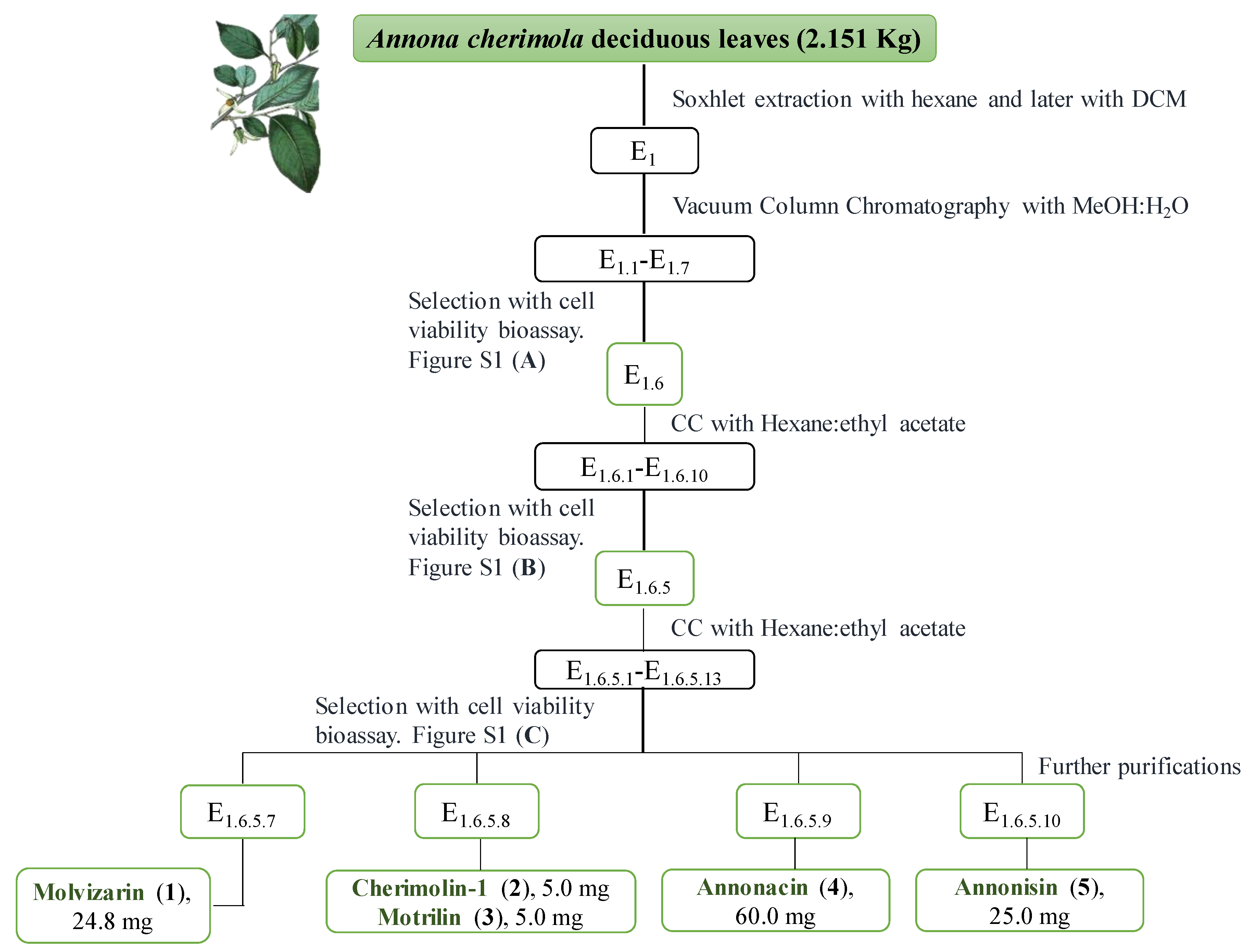

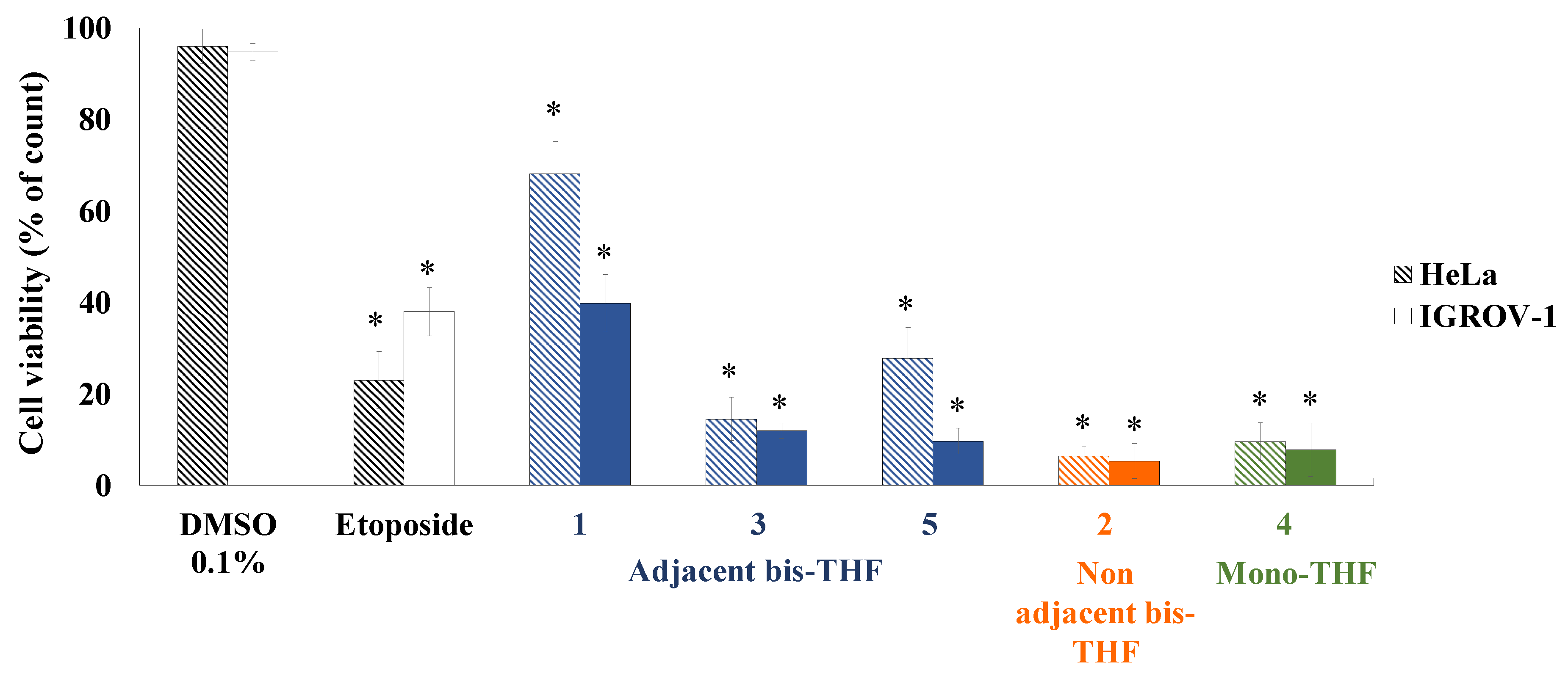
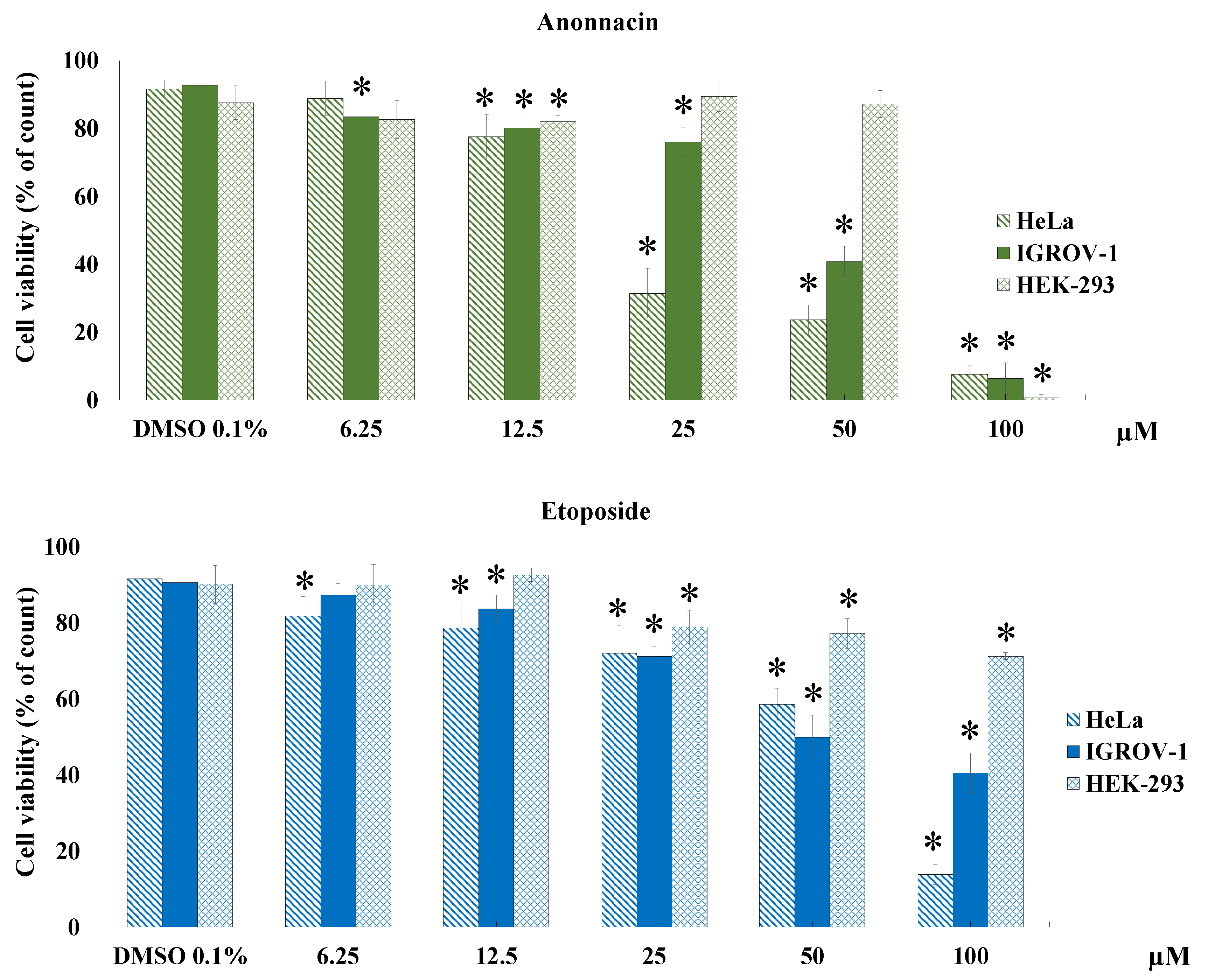
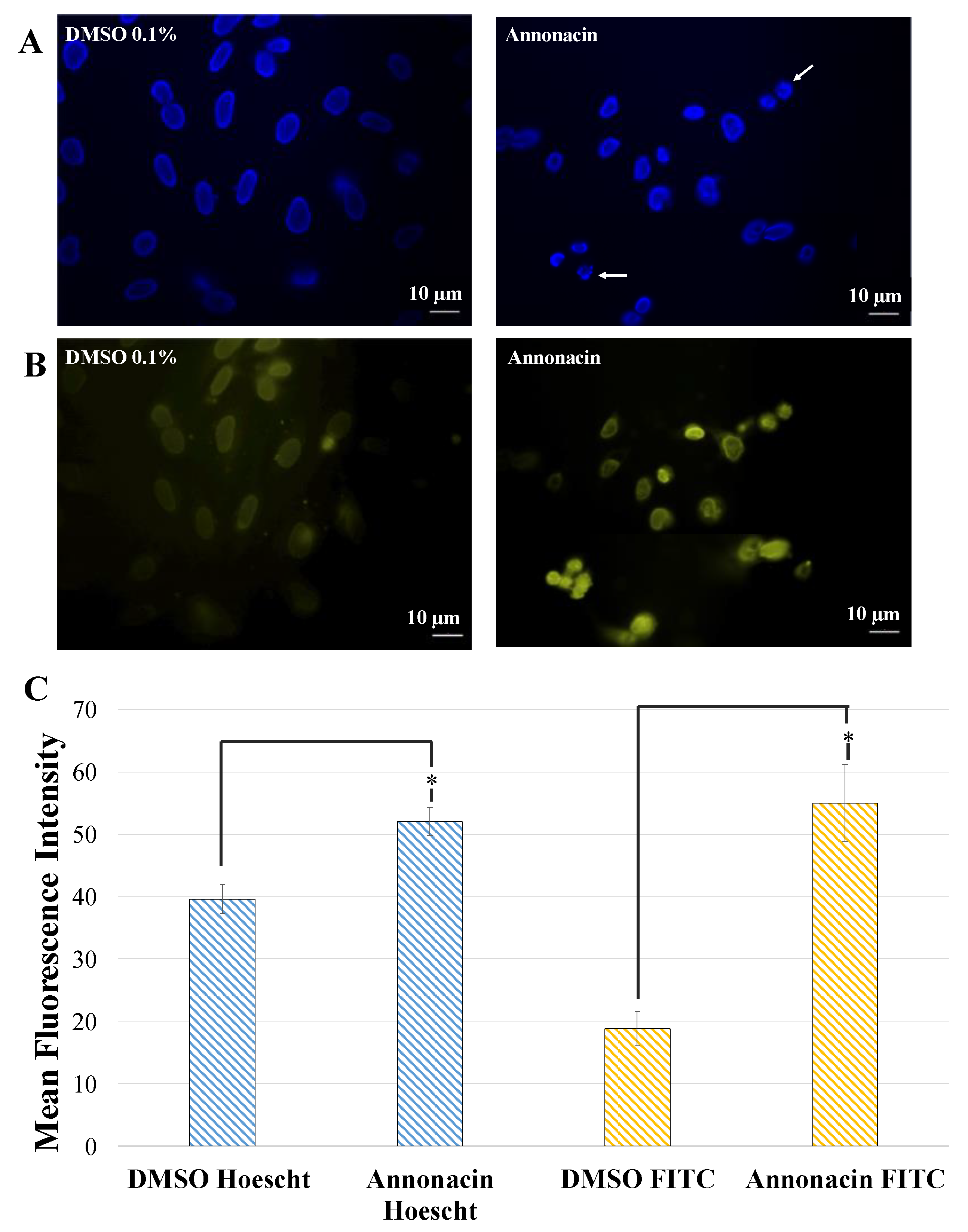
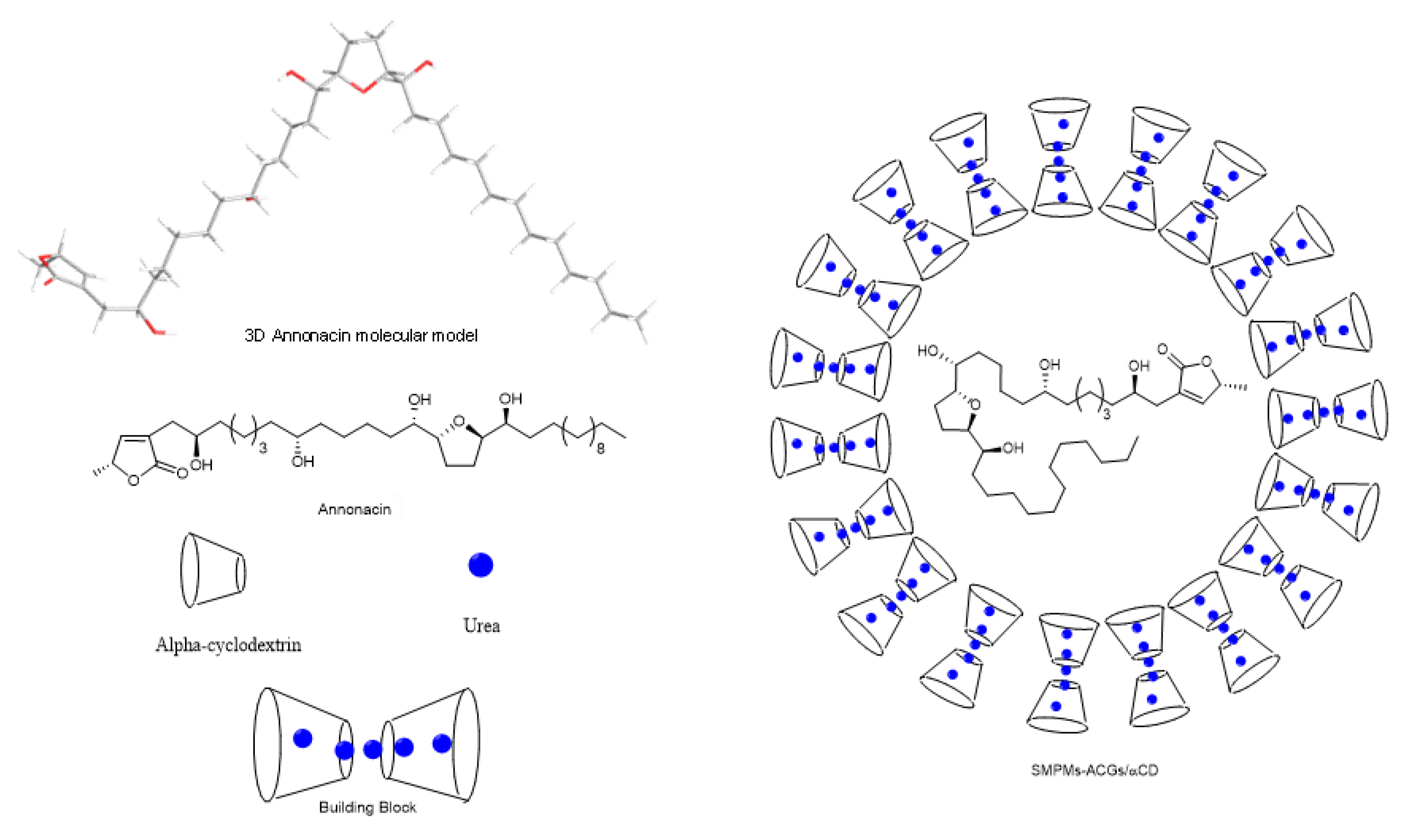



Sample Availability: Samples of the acetogenins molvizarin (1) and annonacin (4) as well as SMPMs of annonacin are available from the authors. |
Publisher’s Note: MDPI stays neutral with regard to jurisdictional claims in published maps and institutional affiliations. |
© 2020 by the authors. Licensee MDPI, Basel, Switzerland. This article is an open access article distributed under the terms and conditions of the Creative Commons Attribution (CC BY) license (http://creativecommons.org/licenses/by/4.0/).
Share and Cite
Gutiérrez, M.T.; Durán, A.G.; Mejías, F.J.R.; Molinillo, J.M.G.; Megias, D.; Valdivia, M.M.; Macías, F.A. Bio-Guided Isolation of Acetogenins from Annona cherimola Deciduous Leaves: Production of Nanocarriers to Boost the Bioavailability Properties. Molecules 2020, 25, 4861. https://doi.org/10.3390/molecules25204861
Gutiérrez MT, Durán AG, Mejías FJR, Molinillo JMG, Megias D, Valdivia MM, Macías FA. Bio-Guided Isolation of Acetogenins from Annona cherimola Deciduous Leaves: Production of Nanocarriers to Boost the Bioavailability Properties. Molecules. 2020; 25(20):4861. https://doi.org/10.3390/molecules25204861
Chicago/Turabian StyleGutiérrez, Maria Teresa, Alexandra G. Durán, Francisco J. R. Mejías, José M. G. Molinillo, Diego Megias, Manuel M. Valdivia, and Francisco A. Macías. 2020. "Bio-Guided Isolation of Acetogenins from Annona cherimola Deciduous Leaves: Production of Nanocarriers to Boost the Bioavailability Properties" Molecules 25, no. 20: 4861. https://doi.org/10.3390/molecules25204861
APA StyleGutiérrez, M. T., Durán, A. G., Mejías, F. J. R., Molinillo, J. M. G., Megias, D., Valdivia, M. M., & Macías, F. A. (2020). Bio-Guided Isolation of Acetogenins from Annona cherimola Deciduous Leaves: Production of Nanocarriers to Boost the Bioavailability Properties. Molecules, 25(20), 4861. https://doi.org/10.3390/molecules25204861








